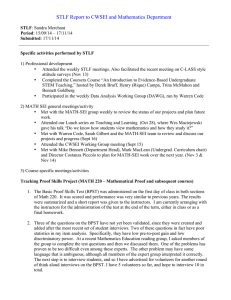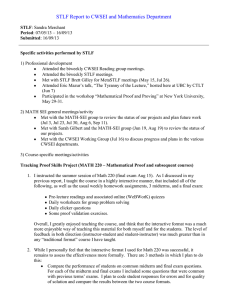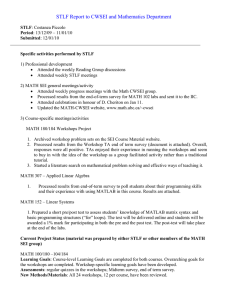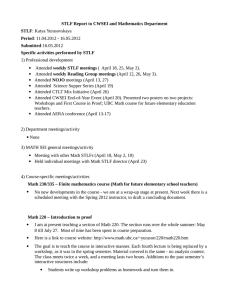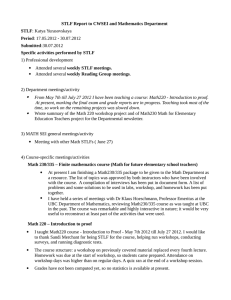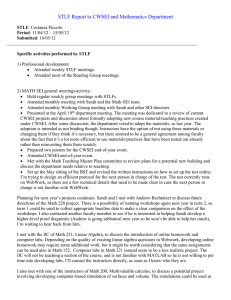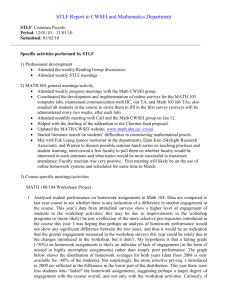STLF Report to CWSEI and Mathematics Department
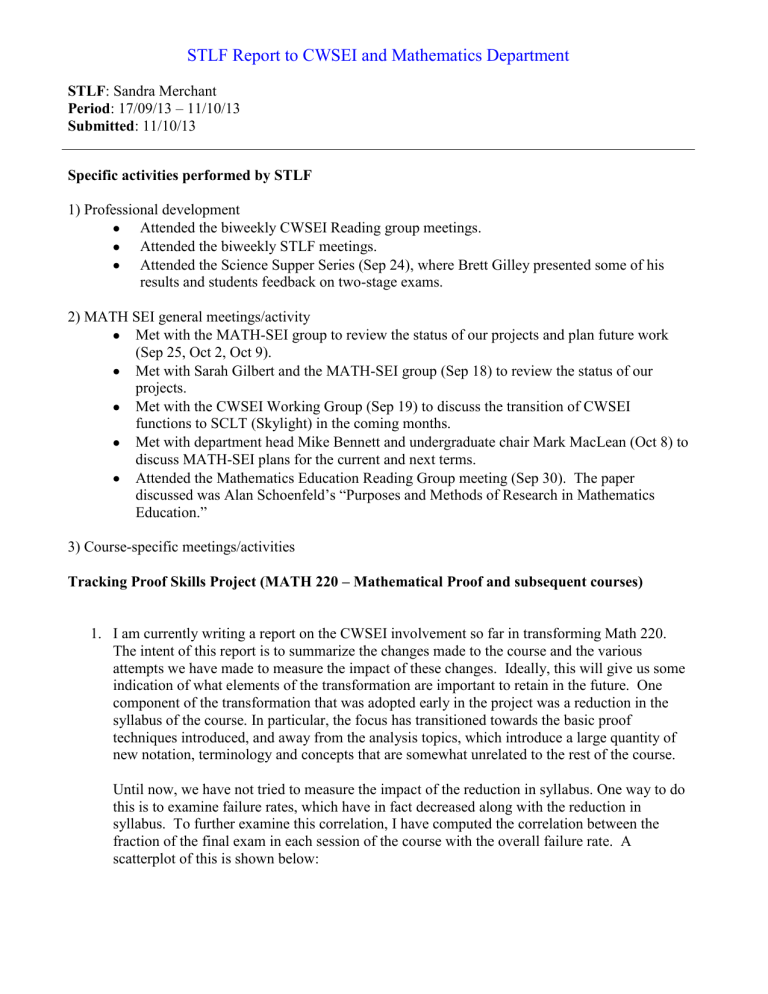
STLF Report to CWSEI and Mathematics Department
STLF : Sandra Merchant
Period : 17/09/13 – 11/10/13
Submitted : 11/10/13
Specific activities performed by STLF
1) Professional development
Attended the biweekly CWSEI Reading group meetings.
Attended the biweekly STLF meetings.
Attended the Science Supper Series (Sep 24), where Brett Gilley presented some of his results and students feedback on two-stage exams.
2) MATH SEI general meetings/activity
Met with the MATH-SEI group to review the status of our projects and plan future work
(Sep 25, Oct 2, Oct 9).
Met with Sarah Gilbert and the MATH-SEI group (Sep 18) to review the status of our projects.
Met with the CWSEI Working Group (Sep 19) to discuss the transition of CWSEI functions to SCLT (Skylight) in the coming months.
Met with department head Mike Bennett and undergraduate chair Mark MacLean (Oct 8) to discuss MATH-SEI plans for the current and next terms.
Attended the Mathematics Education Reading Group meeting (Sep 30). The paper discussed was Alan Schoenfeld’s “Purposes and Methods of Research in Mathematics
Education.”
3) Course-specific meetings/activities
Tracking Proof Skills Project (MATH 220 – Mathematical Proof and subsequent courses)
1.
I am currently writing a report on the CWSEI involvement so far in transforming Math 220.
The intent of this report is to summarize the changes made to the course and the various attempts we have made to measure the impact of these changes. Ideally, this will give us some indication of what elements of the transformation are important to retain in the future. One component of the transformation that was adopted early in the project was a reduction in the syllabus of the course. In particular, the focus has transitioned towards the basic proof techniques introduced, and away from the analysis topics, which introduce a large quantity of new notation, terminology and concepts that are somewhat unrelated to the rest of the course.
Until now, we have not tried to measure the impact of the reduction in syllabus. One way to do this is to examine failure rates, which have in fact decreased along with the reduction in syllabus. To further examine this correlation, I have computed the correlation between the fraction of the final exam in each session of the course with the overall failure rate. A scatterplot of this is shown below:
Correlation between failure rate and
"analysis" content on Math 220 Final Exam
35
30
2010 WT1
2008 WT2
2009 S
2010 WT2
25
2009 WT2
20
2013S
2011 WT2
15
2012 WT1
10
2011 WT1
2012 WT2
5
0
0 10 20 30 40
Proportion of Exam on "Analysis" y = 0.3581x + 11.3
R² = 0.8139
50 60
As we can see, there is a significant correlation between these two factors. Of course, this may not be a causal relationship, but from my past coding of final exams, analysis problems were the most frequent sources of student errors, and hence lost marks. Further investigation is required, but it seems the reduction in syllabus may have played a role in decreasing failure rates in this course.
2.
The workshops developed for Math 220 are going well, with the first 3 (of 6) workshops now completed. Both instructors and students are engaged and seem to enjoy the workshops. I plan to include some questions on an end-of-term survey about the students’ perception of the workshops. I also plan to interview the instructors about the experience at the end of the course.
3.
I have revised the higher-level proof diagnostic test, now being called the “Proof Concept
Survey” (PCS), according to input from faculty members. I then conducted think-aloud interviews individually with 10 students from our Math 320 – Analysis course. Despite the single course source, the participants come from a very large range of backgrounds and skill levels, so I believe it should be sufficient for my needs. Each student completed (as well as they could) the 8 problems we have proposed for the PCS. From the think-aloud interviews, it is clear that two of the problems are not performing our intended function, as students are not using the intended proof technique. These two problems will need to be replaced. The remaining 6 problems are promising, but further analysis of the interviews is needed to identify the key misconception and difficulties students encounter, with the plan of converting these problems to a more focused and easy-to-score form.
Math Attitudes and Perceptions Survey (MAPS) – joint work with Warren Code and Joseph Lo
1.
Based on the expert responses and student data, factor analysis was performed again (by
Warren Code) to finalize the list of statements and categories that will comprise MAPS. Our next step is to compare MAPS with the various existing math attitude instruments, as well as the other CLASS-derived surveys. In addition, we plan to collect and analyze data from the
Math 104/184 population this term, as well collect and analyze student responses at another institution (University of Central Arkansas) in collaboration with Matthew Thomas, a faculty member in Mathematics there.
Current Project Status (material was prepared by either STLF or other members of the MATH
SEI group)
MATH 220:
Learning Goals : Learning goals have previously been created for this course.
Assessments : The following assessments are planned to be used this term: basic proof diagnostic (pre and post), end-of-term survey (including questions on workshops).
New Methods/Materials : A proof concept survey is under development to assess higher-level proof skills.
Plan for immediate future work
MATH 220:
1.
Continue working on my papers about the BPST and its use in Math 220.
2.
Perform student validation on the portions of the basic proof skills diagnostic that have not been validated.
3.
Prepare workshop problem and solutions sets for each of the remaining 3 workshops in each section.
4.
Complete the progress report about CWSEI work in Math 220, in order to present and discuss the contents in a focus group later in the term.
5.
Examine the BPST results from Summer 2013 on a question-by-question basis to see if the higher learning gains for that session are caused by only a single element of the test or if it is the result of improvement in multiple skills.
Higher-Level Proof Courses
1.
Analyze the student think-alouds on the PCS problems, and (where possible) convert problems to a more easily scored form. The goal is to have an easy-to-score version of the test for use in
Math 342 in Jan 2014.
2.
Replace the 2 ineffective problems on the PCS with problems that target the desired skills.
Interview students on these two problems, in conjunction with BPST validation interviews.
MAPS
1.
Compare and contrast our MAPS instrument with other existing math attitude surveys as well as with CLASS-derived instruments in other disciplines.
2.
Collect and analyze student responses on MAPS for Math 104/184, and from the University of
Central Arkansas.
